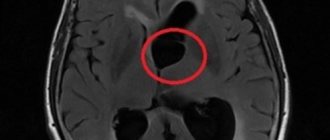Cerebral ischemia is a condition that develops in response to oxygen starvation due to cerebral circulatory failure.
There are acute and chronic cerebral ischemia. Acute ischemia occurs with a sharp development of oxygen starvation and occurs as a transient ischemic attack or ischemic stroke (cerebral infarction). Chronic ischemia develops gradually in response to long-term cerebral circulatory failure.
In this article we will look at chronic cerebral ischemia.
Chronic cerebral ischemia is a special type of cerebral vascular pathology, caused by a slowly progressive diffuse disruption of the blood supply to the brain with gradually increasing various defects in its functioning. The term “chronic cerebral ischemia” is used in accordance with the International Classification of Diseases, 10th revision, instead of the previously used term “dyscirculatory encephalopathy”.
General information about cerebral ischemia
A disease in which blood circulation to the brain is reduced or completely stopped is called ischemia. The cause of the disorder is a pathological narrowing of the lumen of blood vessels, in which oxygen does not flow in the required volume. Lack of nutrition leads to malfunctions, which are expressed by general malaise and other symptoms.
Medicine has identified two forms of the disease:
- Focal
- in which tissue damage is localized in only one area. The cause is an embolism or blood clot that blocks the blood flow. - Global
- characterized by a decrease or cessation of blood circulation in several areas of the brain.
As a result of oxygen starvation of tissues, ischemia develops. With early diagnosis, complications of the disease can be avoided.
Complications
The lack of an effective treatment plan leads to a long-term lack of oxygen supply to the brain. This can provoke:
- stroke;
- necrotic changes in brain cells;
- epileptic seizures accompanied by fainting;
- inflammation of the veins of the lower extremities, the appearance of blood clots;
- atherosclerotic changes in blood vessels;
- paralysis.
In addition, sensitivity is impaired, and pain becomes chronic. The patient develops a depressive syndrome.
Classification of cerebral ischemia
The deterioration of vascular activity occurs with varying degrees of severity, therefore two types of the disease are distinguished:
- Acute
, characterized by the suddenness of the onset of symptoms and the minimum period of development of the disease (stroke, cerebral infarction). - Chronic
, occurs as a result of the slow development of brain dysfunction due to diffuse (extensive) or small focal damage to brain tissue in conditions of prolonged insufficiency of cerebral blood supply. In this condition, patients develop symptoms gradually, with further progression.
Vascular pathology occurs not only in adults, but even in newborns due to a lack of oxygen during the mother’s pregnancy.
Diagnosis of the disease
Great importance is attached to collecting anamnesis, the presence in the medical history of myocardial infarction, coronary artery disease, angina pectoris, arterial hypertension, atherosclerosis of the extremities, and diabetes mellitus. During the examination, it is necessary to measure blood pressure in the arms and legs, and listen to the sounds of the heart and abdominal aorta.
A number of laboratory tests are prescribed to study general blood parameters, PTI, blood glucose levels, and lipid parameters. Electrocardiography, ophthalmoscopy, neck spondylography, ultrasound of the arteries of the head, duplex and triplex examination of intracranial and extracranial blood vessels are prescribed to determine the degree of damage to the brain matter. Contrast radiography of cerebral vessels is performed to identify pathologies of vascular development.
Differential diagnostic measures are aimed at excluding somatic pathologies and oncological diseases. Manifestations of chronic ischemic cerebral disease are similar to signs of borderline and endogenous mental disorders.
Parkinson's disease, multiple system atrophy, progressive supranuclear palsy, corticobasal degeneration, and Alzheimer's disease have similar neurological symptoms. When confirming the diagnosis, signs of idiopathic dysbasia, ataxia, and brain tumors should be excluded.
Symptoms of cerebral ischemia
In the case of an acute process (hemorrhagic or ischemic stroke), the first signs of the disease appear brightly and clearly; with timely diagnosis, treatment can be quickly started with a favorable prognosis in the future. Symptoms in this case will depend on the area of brain damage.
With chronic ischemia, the following appear:
- deterioration of brain activity,
- deterioration of intellectual development,
- depression of the psycho-emotional state (irritability, apathy, hysteria, depression, insomnia).
Concentration of attention during mental stress is impaired, fatigue and anxiety appear. The appearance of such symptoms goes unnoticed by a person for a long time, and the disease develops to an irreversible process.
Over time, patients experience the following symptoms in addition to the above:
- headache;
- nausea, vomiting;
- dizziness;
- lack of coordination when walking;
- deterioration of sensitivity in the limbs;
- depression of visual and auditory function;
- fainting.
Lack of adequate treatment for the disease leads to dementia (dementia). In this case, patients partially or completely lose work skills and the ability to self-care.
To prevent dangerous complications of chronic cerebral ischemia, you need to undergo diagnosis and begin treatment.
Stages of development
Stage I is characterized by the simultaneous appearance of microfocal neurological signs (anisoreflexia, verbal automatism). The patient experiences changes when walking (slowness, small steps). When the patient is asked to perform coordination tests, uncertainty of movements and instability are noted.
Relatives and relatives notice short temper, increased anxiety, signs of depression and emotional lability in the patient. In addition to these symptoms, inertia, slowing of thought processes, and variations in attention appear. Neuropsychological tests do not reveal any abnormalities. There are no restrictions in the daily life of patients.
In stage II, neurological symptoms increase significantly. The dominant syndrome is determined, although it is not yet expressed enough. Extrapyramidal symptoms are expressed in the form of ataxia, dysfunction of the cranial nerves, and partial pseudobulbar syndrome. Prosoparesis and glossoparesis are observed.
Patients note the same complaints, but attach special significance to them. Emotional disturbances are increasing. Cognitive pathologies worsen, and dysregulatory neurodynamic disorders appear. The patient cannot plan his actions or control his actions. When performing neuropsychological tasks, the patient experiences significant difficulties, but understands how to use the prompts. Over time, experiences difficulty in adjusting socially and professionally.
Stage III is determined by severe neurological symptoms. While walking, the patient often falls. Possible urinary incontinence and development of parkinsonian syndrome. The patient complains less about any symptoms, as he loses self-criticism. Personality and behavior disorders are recorded - aggressiveness, irritability, disinhibition, apathetic-abulsic syndrome.
Neurologists note disorders of memory, cognition, speech, and praxis. At this stage, the development of dementia and disability is possible. Patients cannot take care of themselves in everyday life.
Diagnosis of cerebral ischemia
To identify a dangerous disease, neurologists use an integrated approach to diagnosis. During the examination, the doctor collects anamnesis and conducts a primary examination, for example, a finger-nose test. To do this, the patient is asked to stand up, align his legs shoulder-width apart, spread his arms to the sides, bending them at an angle of 90 degrees, and close his eyes. Next, the patient should touch the tip of the nose with the index finger. With developing ischemia, contact between the two surfaces will not occur, and the missed finger will certainly point in the direction of the damaged lobe.
In addition to the finger-nose test, the doctor will examine other abilities of the patient, such as facial expressions, pupil reaction, facial symmetry, clarity of speech and coordination. Along with the examination, the necessary tests are additionally collected:
- Blood pressure is measured in a doctor's office.
- Detection of vascular lesions of the fundus is carried out by an ophthalmologist.
- Undergoing electrocardiography for correct diagnosis.
- Dopplerography of blood vessels is mandatory.
- Electroencephalography reveals inactive areas of the brain.
- CT (computed tomography), MRI (magnetic resonance imaging) perform an in-depth examination.
- A biochemical blood test evaluates cholesterol levels.
Doctors use differential diagnostic methods, since the symptoms of the pathology are similar to the manifestations of other diseases of an infectious, allergic, neurological and oncological nature.
What to do if MRI shows chronic ischemia?
If, when decoding the results of a head scan, the presence of ischemic brain disease is detected, it is recommended to consult a neurologist. You may need to consult a therapist or cardiologist. To slow the progression of ischemic damage, it is necessary to achieve target levels of blood pressure, blood glucose and cholesterol levels. Doctors will evaluate metabolic changes and select treatment to compensate for chronic diseases.
The diagnostic department performs MRI of the brain from 2,690 rubles. Contrasting is carried out from the age of 12. You can ask the administrator any questions you may have by calling +7 (812) 407-32-31.
Treatment of ischemic cerebral disease
Therapy for cerebral vascular ischemia consists of a conservative (medicinal) treatment method and a surgical one. The first method is aimed at improving vascular tone and blood pressure. The doctor will adjust the patient’s diet to eliminate the risk of the formation of atherosclerotic plaques and blood clots. But if they are already present, additional medications are prescribed in addition to the diet. In most cases, it is hypertension and atherosclerosis that are the root cause of the development of ischemia.
Drug treatment consists of the following:
- antihypertensive, reducing blood pressure in the vessels;
- lipid-lowering drugs (statins), which reduce cholesterol deposits;
- antiplatelet, blood thinning, preventing the formation of blood clots;
- nootropic, normalizing brain functioning;
- antioxidant, improving oxygen supply to tissues;
- anxiolytics and sedatives that reduce the manifestations of hyperexcitability.
Chronic ischemia requires more in-depth diagnosis, as well as radical treatment. Surgery is often necessary:
- stenting of the carotid arteries - expansion of the narrowing site using a metal tube;
- carotid endarterectomy - removal of plaque from the carotid arteries.
If the cause of chronic vascular disease is a blood clot or plaque, then during surgery they will be removed, which allows the patient to return normal vascular tissue, which will supply the brain with oxygen in full.
Neurologists advise not to overwork, get enough sleep and lead a healthy lifestyle, since discirculatory encephalopathy does not result in a quick recovery without following a diet and changing lifestyle.
Rehabilitation after surgery
Further rehabilitation measures consist of the following stages:
- Rehabilitation in a hospital setting during the patient’s hospitalization.
- Rehabilitation in a hospital department or in a sanatorium after the end of the acute period of illness.
- Outpatient clinic or home.
Blood supply to the brain
The normal functioning of the brain requires a large amount of energy. Nutrients and oxygen are delivered to the cells of the nervous tissue through the bloodstream. Nature has taken care to create a high degree of reliability of blood supply to the brain. It is provided by four powerful main arteries: two carotid and two vertebral. At the base of the brain, the branches of these vessels form a closed circle, called Willisian after the English physician and anatomist of the 17th century, Thomas Willis, who first described it. Thanks to this, the lack of blood supply in one of the main vessels is compensated by others. It also happens that even with serious disturbances in blood flow in three of the four main vessels, a person complains only of a slight deterioration in well-being - the compensatory capabilities of the brain are so great. Great, but, unfortunately, not unlimited. Man manages to “shatter” these perfect compensation mechanisms created by nature. It all starts with the most ordinary complaints of headache, dizziness, memory loss and fatigue.
After some time, the patient develops more serious neurological symptoms, indicating multiple brain damage. The reason for this is chronic cerebral circulatory failure, or “dyscirculatory encephalopathy.” This term was proposed in 1971 by well-known domestic scientists working at the Research Institute of Neurology of the Russian Academy of Medical Sciences, Academician of the Russian Academy of Medical Sciences E.V. Shmidt and Candidate of Medical Sciences G.A. Maksudov, and it means changes in the brain associated with disturbances in its blood supply.
The main causes of the occurrence and development of dyscirculatory encephalopathy are arterial hypertension and atherosclerosis.
More than 40% of the adult population of Russia suffers from hypertension. Men and women, old people and young people get sick. Only in 5% of cases the cause of hypertension is clear. These may be renal failure, endocrine disorders, atherosclerosis and some other diseases. In 95% of cases, the cause of hypertension remains unclear, which is why it is called essential (literally, hypertension itself). With hypertension, the walls of blood vessels become denser, local narrowings (stenoses) and tortuosity are formed. All this leads to circulatory disorders, including blood supply to the brain. Sometimes it comes to occlusion - complete closure of the lumen of the vessel.
Blood clots, thrombi, develop in the area of atherosclerotic plaques that form on the inner walls of the vessel. Blood clots can completely block even large vessels, causing serious cerebrovascular accidents. (Image: Science and Life)
Unlike hypertension, the cause of atherosclerosis is known - it is a disorder of lipid metabolism. In patients with atherosclerosis, the level of fat-like substances in the blood increases - cholesterol, low-density lipoproteins, triglycerides, which are deposited on the walls of blood vessels, forming lipid stains. Then the spots grow into so-called plaques. Due to the deposition of calcium salts, the plaques become denser and ultimately narrow or even close the lumen of the blood vessels. Then they begin to disintegrate, their particles - emboli - enter the bloodstream and sometimes clog other small and large vessels.
Sometimes the development of dyscirculatory encephalopathy is facilitated by osteochondrosis, since in this disease, due to deformation of the intervertebral discs, the vertebral arteries that supply the brain with blood can be pinched.
Impaired blood supply leads to the gradual death of neurons in various parts of the brain, and the patient experiences neurological symptoms. Discirculatory encephalopathy is most characterized by emotional and personal disturbances. At the onset of the disease, asthenic conditions are noted: general weakness, irritability, poor sleep. Asthenia is often accompanied by depression. Gradually, such painful personality traits as egocentrism and periodically occurring causeless agitation begin to appear, which can be pronounced and manifest itself in inappropriate behavior. With further development of the disease, emotional reactivity decreases and gradually turns into dullness and apathy.
Once it begins, the disease steadily progresses, although during its course both sharp periodic deterioration (paroxysmal course) and periods of slow increase in symptoms of the disease can be observed.
We should not forget that dyscirculatory encephalopathy increases the risk of many severe brain diseases and, above all, stroke - an acute circulatory disorder of the brain (Manvelov A., Candidate of Medical Sciences; Kadykov A., Doctor of Medical Sciences. “Stroke is a social problem and medical” // “Science and Life” 2002, No. 5.). In Russia, strokes are registered in more than 400 thousand people per year. Of these, 35% die in the first three weeks of the disease, and only half of the patients reach the annual milestone. The possibility of epileptic seizures occurring against the background of developing discirculatory encephalopathy should not be excluded.
Forecast and prevention of cerebral ischemia
When the first symptoms occur, the patient should visit a neurologist. Timely treatment will help prevent complications and an undesirable prognosis for the patient. Ischemia of the blood vessels of the head against the background of high blood pressure progresses quickly, so the patient’s concern for his health should begin with an examination by a doctor.
Prevention of vascular exacerbations includes following a diet, quitting smoking, alcohol, weight control, and avoiding stress. In case of aggravating factors (diabetes, hypertension), observation by a specialist should be systematic. Doctors do not recommend long periods of physical activity or frequent sun exposure for elderly patients.
Prognosis, disease prevention
If the dynamics of chronic cerebral ischemia are suspected, timely diagnosis and the prescription of adequate drug therapy are important. The course of the disease is significantly worsened by the presence of concomitant pathological conditions - hypertension, diabetes mellitus. In severe clinical cases, the patient may become disabled.
Prevention consists of preventing the development of ischemic factors. Risk factors include: obesity, sedentary lifestyle, smoking, excessive alcohol consumption, frequent stressful situations.
Folk remedies
Photo: veronikaa.ru
Therapy for chronic cerebral ischemia lasts for years; doctors often combine methods of traditional and alternative medicine. Folk remedies must be used in combination with pharmacological drugs. Before use, you should consult a neurologist and cardiologist.
Many plants have anti-sclerotic and antioxidant properties, that is, they help reduce the risk of cholesterol plaques and help restore the function of blood vessels. Nonea dark herb, motherwort, mint, dill seeds and thyme thin the blood. All components must be mixed in equal proportions, pour 2 tablespoons of the mixture with half a liter of boiling water and leave. Take, strain, 100 ml three times a day 30 minutes before meals. The course of therapy is 3 weeks.
To speed up the restoration of cerebral circulation, you need to take an infusion of Galega officinalis. Pour two cups of boiling water over the grass and seeds (15 grams), leave for several hours and strain. Drink 100 ml twice a day before meals. An infusion of sweet clover has similar properties. The method of preparation and administration is similar. The course of treatment is 2 weeks. You can repeat it after 10 days.
The information is for reference only and is not a guide to action. Do not self-medicate. At the first symptoms of the disease, consult a doctor.
SEARCH FOR TREATMENT AROUND THE WORLD WITH YELLMED
Read also
Swelling of the legs
Causes of Swelling in the Legs The legs are common sites for swelling due to the effect of gravity on the fluids in the human body.
However, fluid retention is not the only cause of leg swelling. Injuries… Read more
Hemorrhagic stroke
Hemorrhagic stroke is a type of acute cerebrovascular accident, which is characterized by the effusion of blood into the brain substance with the development of neurological deficit, often leading...
More details
Alzheimer's disease
47,000,000 people suffer from dementia in the world. Doctors call Alzheimer's disease the most common cause of dementia. Alzheimer's disease is a progressive neurodegenerative disease accompanied by...
More details
Vegetative-vascular dystonia
Vegetative-vascular dystonia is a dysregulation of the autonomic nervous system, which manifests itself in the form of various clinical symptoms. This disease is diagnosed at different times...
More details
Transient ischemic attack (TIA)
What it is? Why is this happening? Is this condition dangerous? What to do if doctors make such a diagnosis? These questions are always asked by patients who come to see a neurologist. According to classification...
More details









